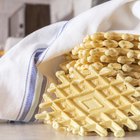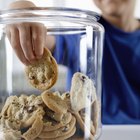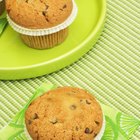merc67/iStock/GettyImages
How to Store Long-Lasting Breads, Cookies, Cakes and Crackers
Keeping your baked goods fresh as long as possible depends to a large extent on the items themselves. Bagels and baguettes go stale after one or two days; brownies may last up to five days, assuming that they haven't been eaten before the five days are up; cookies last for about a week. Luckily, wrapping methods, moisture-packed additives and freezing all provide options for extending the shelf life of most homemade baked goods.
Why Baked Good Go Stale
In simple terms, breads, cookies and cakes become stale when air dries them out. This process, called starch retrogradation in scientific terms, happens when the starch molecules in the baked goods stiffen up and begin to let go of the water molecules they absorbed during baking. Cookies and cakes undergo this process more slowly than crackers, because they contain more sugar, eggs and fat molecules that also hold in moisture along with the starch molecules.
Tips for Most Baked Goods
With the exception of crusty breads, such as French bread and baguettes, most baked goods stay fresh if you wrap them in plastic or foil, or if you store them in any airtight container, whether plastic, metal or glass, to keep moisture from escaping. Make sure you cool the baked goods completely before storing, or excess moisture will turn them soggy. And don't store soft cookies and crispy cookies in the same container; crisp cookies will absorb the moisture that the soft cookies give up.
Freezing Bread and Cookies for Freshness
While refrigeration actually dehydrates baked goods – because refrigerators maintain a very low level of humidity – freezing keeps cookies and breads fresh. Use freezer-grade plastic bags or wrapping, or double-wrap your baked goods in plastic and foil to keep air and moisture out. All cookie varieties stay fresh for up to three months in the freezer, and bread stays good for about three weeks.
Keeping Cookies Soft
Crisp cookies like gingersnaps pose fewer problems with staying fresh than soft cookies, like snickerdoodles, because they already contain little moisture and are meant to be crunchy. If you made soft cookies, place a few apple slices or a slice of soft sandwich bread into your cookie jar or into the plastic bag with the cookies. The apple slices or bread create just the right environment, giving off some of their liquid, to keep soft cookies from losing too much moisture.
Reviving Bread and Cookies
You have lots of options to bring stale bread, cookies and crackers back to life. Toasting stale bread softens the starch molecules, allowing the slice to reabsorb moisture from the air. Reheating bread, cookies or crackers in the oven also works; recrisp cookies in a 300F oven for about 5 minutes, soft bread loaves for 5 to 10 minutes, depending on the size of the loaf, and crackers for 10 minutes. To revive crusty bread so the crust crisps up while the inside stays soft, extend the time in the oven from 10 to 12 minutes.
Related Articles

How to Make Pizzelle Crisp in High ...

Does Bread Expire?

How to Use Bread to Soften Brownies

Can Humidity Affect Cookies?

How to Keep Muffins From Going Moldy

How to Keep Sandwich Bread Fresh All ...

How Long Does Banana Bread Stay Fresh?

How to Keep Croissants Fresh Overnight
Why Isn't It a Good Idea to Store ...

How to Freeze Brioche
How Do You Store Fresh Dates?

How to Keep Baked Goods Moist Overnight

How to Soften Hard Sugar Cookies

How to Make Soft Bread Crumbs

Can You Bake Wonton Wrappers Instead of ...
How to Keep Indian Fry Bread Fresh

Does Light Affect How Long Bread Will ...
How to Freeze a Baguette

How to Soften Overly Hard Bread

How to Store Fresh Baked Bread
References
Resources
Tips
- If you don’t have a glass cake plate with a dome, turn a large bowl upside down and use it to cover your baked goods.
Writer Bio
Susan Lundman began writing about her love of cooking, ingredient choices, menu planning and healthy eating after working for 20 years on children's issues at a nonprofit organization. She has written about food online professionally for ten years on numerous websites, and has provided family and friends with homemade recipes and stories about culinary adventures. Lundman received her M.A. from Stanford University.